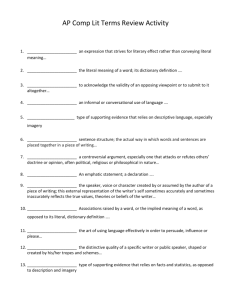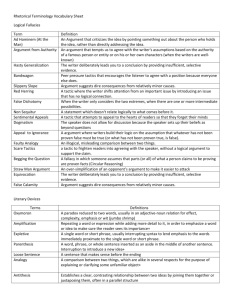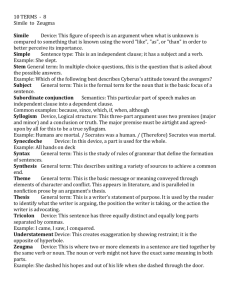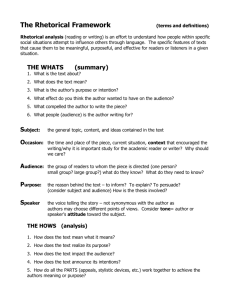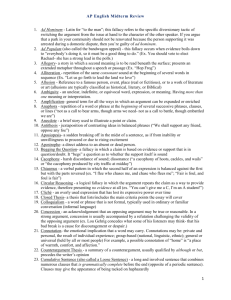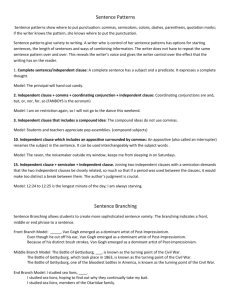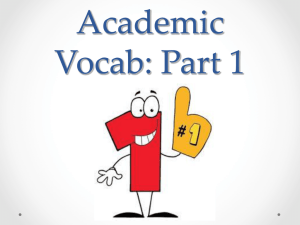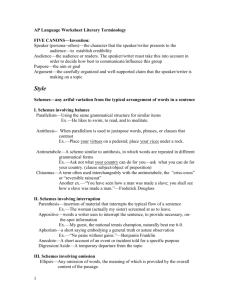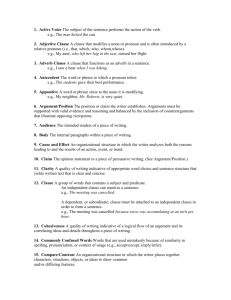AP Comp Midterm Review Activity
advertisement
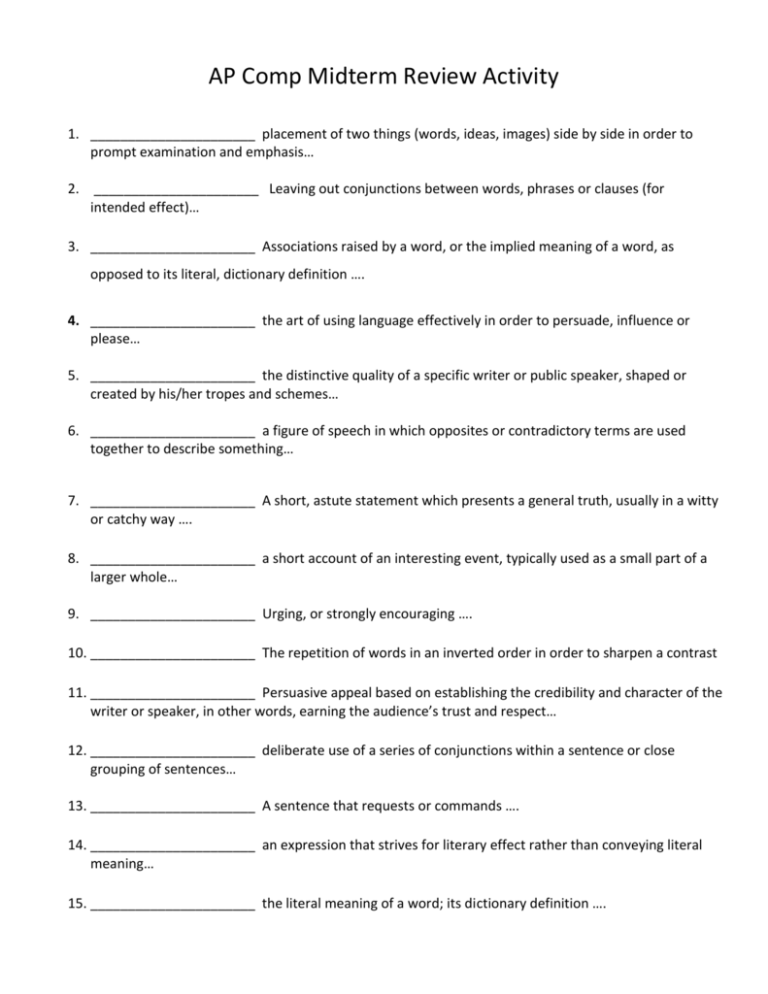
AP Comp Midterm Review Activity 1. ______________________ placement of two things (words, ideas, images) side by side in order to prompt examination and emphasis… 2. ______________________ Leaving out conjunctions between words, phrases or clauses (for intended effect)… 3. ______________________ Associations raised by a word, or the implied meaning of a word, as opposed to its literal, dictionary definition …. 4. ______________________ the art of using language effectively in order to persuade, influence or please… 5. ______________________ the distinctive quality of a specific writer or public speaker, shaped or created by his/her tropes and schemes… 6. ______________________ a figure of speech in which opposites or contradictory terms are used together to describe something… 7. ______________________ A short, astute statement which presents a general truth, usually in a witty or catchy way …. 8. ______________________ a short account of an interesting event, typically used as a small part of a larger whole… 9. ______________________ Urging, or strongly encouraging …. 10. ______________________ The repetition of words in an inverted order in order to sharpen a contrast 11. ______________________ Persuasive appeal based on establishing the credibility and character of the writer or speaker, in other words, earning the audience’s trust and respect… 12. ______________________ deliberate use of a series of conjunctions within a sentence or close grouping of sentences… 13. ______________________ A sentence that requests or commands …. 14. ______________________ an expression that strives for literary effect rather than conveying literal meaning… 15. ______________________ the literal meaning of a word; its dictionary definition …. 16. ______________________ when the verb precedes the subject in a sentence, disrupting the typical sentence pattern or order of words …. 17. ______________________ repetition of words at the beginning of successive clauses …. 18. ______________________ a figure of speech in which an implied comparison presents one thing as though it were something else; an implicit comparison …. 19. ______________________ term used for the author, speaker or person whose perspective (real or imagined) is being advanced in a speech or piece of writing… 20. ______________________ Parallel structure that juxtaposes contrasting ideas …. 21. ______________________ A statement put forth, and supported by evidence …. 22. ______________________ type of sentence in which the subject and verb (independent clause) are placed at the beginning, followed by numerous additional details (dependent clauses) which add information to the initial idea… 23. ______________________ A direct, straightforward sentence that makes a strong statement …. 24. ______________________ A statement that seems contradictory and therefore impossible and untrue, yet upon reflection contains truth… 25. _______________________ repetition of similar grammatical or syntactical patterns… 26. _______________________ type of appeal which intends to persuade through logic and reasoning, in other words, making the audience understand the argument… 27. ______________________ a figure of speech in which opposites or contradictory terms are used together to describe something… 28. _____________________ intentional exaggeration, used for impact, effect or emphasis …. 29. ______________________ a question which expects no answer, used to draw attention to a point… 30. ______________________ an opposing argument… 31. _______________________ a writer’s attitude toward his/her subject… 32. ______________________ acknowledging the validity of an opposing viewpoint or yielding to it altogether… 33. ______________________ the literal meaning of a word; its dictionary definition …. 34. ______________________ a word or phrase that renames a nearby noun or pronoun …. 35. ______________________ type of sentence in which the main idea of the sentence (independent clause) is presented at the end, following a series of details that presents much information (dependent clause(s))… 36. ______________________ a well-known reference, often to history, pop culture or the Bible… 37. ______________________ to acknowledge the validity of an opposing viewpoint or to submit to it altogether… 38. ______________________ an informal or conversational use of language …. 39. ______________________ descriptive language, typically that appeals to one of the five senses… 40. ______________________ sentence structure; the actual way in which words and sentences are placed together in a piece of writing… 41. ______________________ a controversial argument, especially one that attacks or refutes others’ doctrine or opinion, often political, religious or philosophical in nature… 42. ______________________ An emphatic statement; a declaration …. 43. ______________________ the speaker, voice or character created by or assumed by the author of a piece of writing; this external representation of the writer’s self sometimes accurately and sometimes inaccurately reflects the true values, theories or beliefs of the writer… 44. ______________________ type of sentence in which the subject and verb (independent clause) are placed at the beginning, followed by numerous additional details (dependent clauses) which add information to the initial idea… 45. ______________________ reading actively, by diligently marking up the text as one reads… 46. ______________________ to deny the validity of an opposing argument… 47. ______________________ A belief or statement taken for granted without proof …. 48. ______________________ continual and systematic advancement of specific beliefs or doctrine, reflecting the views of those who adhere to such beliefs or doctrine… 49. ______________________ the situation or occasion of a speech or text… 50. ______________________ a sentence that contains both dependent and independent clauses
